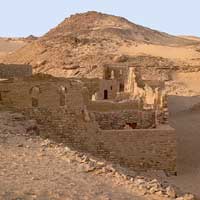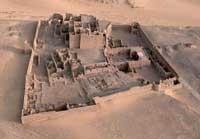|
St. Simeon Monastery
(Monastery of Anba Hatre)
 Those on a fairly standard tour of Egypt that includes the Aswan
area will most likely visit St. Simeon (Deir Anba Sim'an), the
monastery otherwise known as Anba Hatre. It is very likely that
this will also include their one substantial camel ride (about
15 minutes), which is how these ruins, located some one thousand
two hundred meters from the west bank oppose the southern tip of
the island of Elephantine, are usually accessed. The monastery
was given the name St. Simeon by archaeologists and travelers,
but earlier Arabic and Coptic sources called it Anba Hatre (Hidra,
Hadri, Hadra), after an anchorite who was consecrated a bishop
of Syene (now Aswan) by Patriarch Theophilus (385-412 AD). Those on a fairly standard tour of Egypt that includes the Aswan
area will most likely visit St. Simeon (Deir Anba Sim'an), the
monastery otherwise known as Anba Hatre. It is very likely that
this will also include their one substantial camel ride (about
15 minutes), which is how these ruins, located some one thousand
two hundred meters from the west bank oppose the southern tip of
the island of Elephantine, are usually accessed. The monastery
was given the name St. Simeon by archaeologists and travelers,
but earlier Arabic and Coptic sources called it Anba Hatre (Hidra,
Hadri, Hadra), after an anchorite who was consecrated a bishop
of Syene (now Aswan) by Patriarch Theophilus (385-412 AD).
 Even though much of the monastery is in ruins, many of its main
features are well preserved. It is of considerable architectural
interest, for the church provides the most important example of
an oblong, domed Christian church in Egypt and the keep, or
tower, which served as a permanent residential complex, is the
most developed of its kind. Furthermore, the large number of
tombstones in the monastery cemetery are invaluable sources for
the study of early Christian tombstones in the Nile Valley, and
the kilns of the monastery have also proven significant for
research into archaic Aswan pottery. Even though much of the monastery is in ruins, many of its main
features are well preserved. It is of considerable architectural
interest, for the church provides the most important example of
an oblong, domed Christian church in Egypt and the keep, or
tower, which served as a permanent residential complex, is the
most developed of its kind. Furthermore, the large number of
tombstones in the monastery cemetery are invaluable sources for
the study of early Christian tombstones in the Nile Valley, and
the kilns of the monastery have also proven significant for
research into archaic Aswan pottery. |